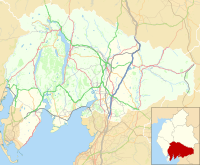Church in Cumbria, England
| St James' Church | |
|---|---|
 St James' Church from the southeast St James' Church from the southeast | |
  | |
| 54°12′06″N 2°49′54″W / 54.2018°N 2.8317°W / 54.2018; -2.8317 | |
| Location | Arnside, Cumbria |
| Country | England |
| Denomination | Anglican |
| Website | St James, Arnside |
| History | |
| Status | Parish church |
| Architecture | |
| Functional status | Active |
| Architect(s) | Miles Thompson Stephen Shaw R. Morton Rigg Austin and Paley |
| Architectural type | Church |
| Style | Gothic Revival |
| Groundbreaking | 1864 |
| Completed | 1914 |
| Administration | |
| Province | York |
| Diocese | Carlisle |
| Archdeaconry | Westmorland and Furness |
| Deanery | Kendal |
| Parish | St James, Arnside |
| Clergy | |
| Vicar(s) | Andrew B. Norman |
St James' Church is in the village of Arnside, Cumbria, England. It is an active Anglican parish church in the deanery of Kendal, the archdeaconry of Westmorland and Furness, and the diocese of Carlisle.
History
The church originated as a small building consisting of a nave and chancel, built in 1864–66, and designed by Miles Thompson. It was extended towards the west in 1884 by Stephen Shaw, further enlarged to the north in 1905 by R. Morton Rigg. A south aisle was added in 1912–14 by the Lancaster architects Austin and Paley.
Architecture
The plan of the church includes a nave with a clerestory, a lean-to north aisle, a south aisle under its own roof, and a chancel. Arising from the roof of the south aisle is a pair of dormers, one higher than the other. Inside the church, the north arcade is carried on octagonal piers, and the south arcade on taller round piers. The stained glass in the east window dates from 1880 and was designed by F. Burrow of Milnthorpe. The two-manual pipe organ was built in about 1920 by Hope-Jones, and refurbished in 1993 by M. Fletcher of Halifax.
See also
References
- St James, Arnside, Church of England, retrieved 10 April 2012
- ^ Hyde, Matthew; Pevsner, Nikolaus (2010) , Cumbria, The Buildings of England, New Haven and London: Yale University Press, pp. 116–117, ISBN 978-0-300-12663-1
- Brandwood, Geoff; Austin, Tim; Hughes, John; Price, James (2012), The Architecture of Sharpe, Paley and Austin, Swindon: English Heritage, p. 248, ISBN 978-1-84802-049-8
- Westmorland (Cumbria), Arnside, St. James (D02983), British Institute of Organ Studies, retrieved 10 April 2012
External links
| Churches in the Deanery of Kendal | |
|---|---|
| Benefice of Arnside | |
| Benefice of the Beacon |
|
| Benefice of Beetham | |
| Benefice of Burton and Holme |
|
| Benefice of Cartmel Fell | |
| Benefice of Crook |
|
| Benefice of Crosscrake | |
| Benefice of Crosthwaite |
|
| Benefice of Heversham and Milnthorpe | |
| Benefice of Kendal Holy Trinity | |
| Benefice of Kendal St Thomas | |
| Benefice of Kirkby Lonsdale | |
| Benefice of Levens |
|
| Benefice of Natland | |
| Benefice of Old Hutton and New Hutton |
|
| Benefice of Underbarrow with Helsington |
|
| Benefice of the Western Dales |
|
| Benefice of Winster |
|
| Benefice of Witherslack | |